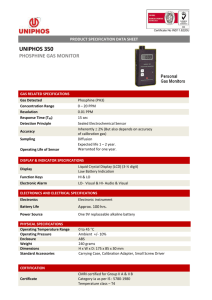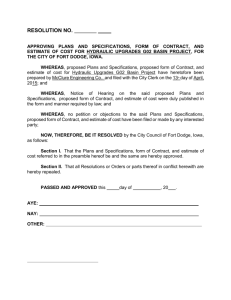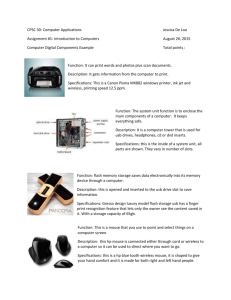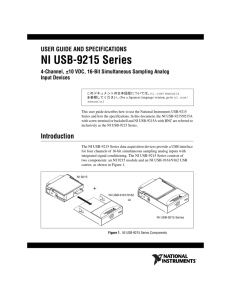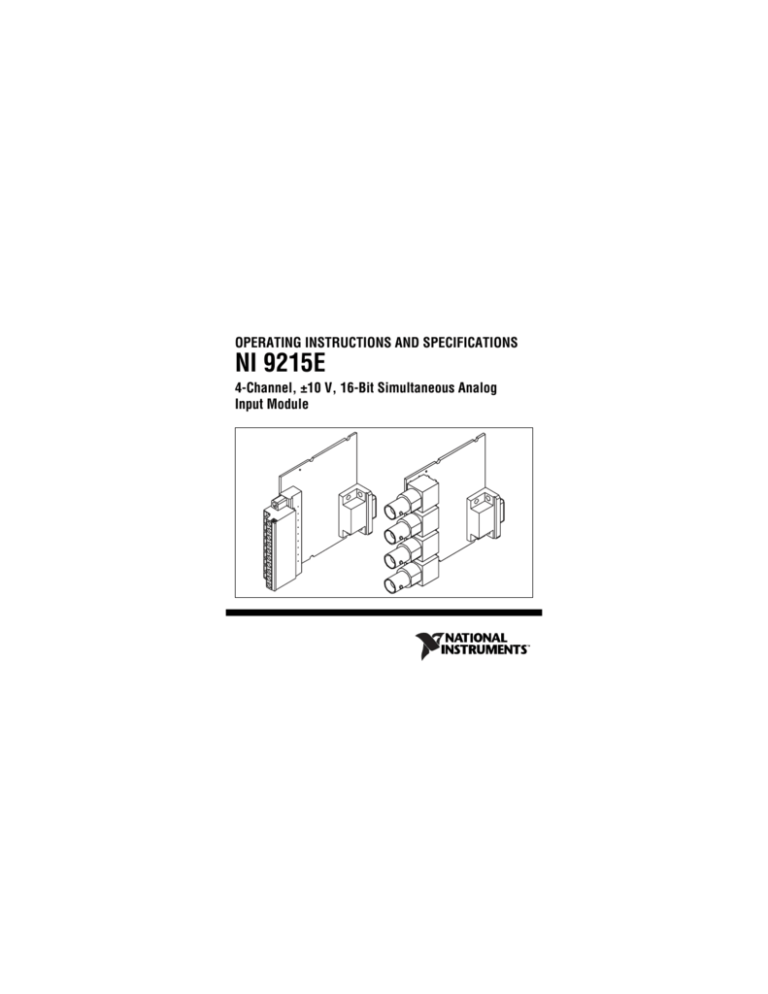
OPERATING INSTRUCTIONS AND SPECIFICATIONS
NI 9215E
4-Channel, ±10 V, 16-Bit Simultaneous Analog
Input Module
This document describes how to use the National Instruments 9215E
and includes dimensions, terminal assignments, and specifications for
the NI 9215E. In this document, the NI 9215E with screw terminal and
NI 9215E with BNC are referred to inclusively as the NI 9215E. Visit
ni.com/info and enter rdsoftwareversion to determine which
software you need for the modules you are using. For information
about installing, configuring, and programming the system, refer to the
system documentation. Visit ni.com/info and enter cseriesdoc
for information about C Series documentation.
National Instruments makes no electromagnetic
compatibility (EMC) or CE marking compliance claims
for the NI 9215E. The end-product supplier is responsible
for conformity to any and all compliance requirements.
Caution
Caution The NI 9215E must be installed inside a suitable
enclosure prior to use. Hazardous voltages may be present.
NI 9215E Operating Instructions and Specifications
2
ni.com
NI 9215E Dimensions
The following figure shows the dimensions of the NI 9215E.
73.4 in. (2.89 mm)
58.4 in. (2.30 mm)
66.0 in. (2.60 mm)
26.7 in. (1.05 mm)
0.0 in. (0.00 mm)
0.0 in. (0.00 mm)
Figure 1. NI 9215E Dimensions in Millimeters (Inches)
© National Instruments Corp.
3
NI 9215E Operating Instructions and Specifications
Connecting the NI 9215E
The NI 9215E provides connections for four differential analog
input channels.
AI0+
AI0–
AI1+
AI1–
AI2+
AI2–
AI3+
AI3–
NC
COM
0
1
2
3
4
5
6
7
8
9
Figure 2. Terminal Assignments of the NI 9215E with Screw Terminal
NI 9215E Operating Instructions and Specifications
4
ni.com
AI0+
AI0–
AI1+
AI1–
AI2+
AI2–
AI3+
AI3–
Figure 3. Connector Assignments of the NI 9215E with BNC
© National Instruments Corp.
5
NI 9215E Operating Instructions and Specifications
The NI 9215E with screw terminal has a 10-terminal detachable
screw-terminal connector. The NI 9215E with BNC has four BNC
connectors.
Each channel of the NI 9215E has an AI+ terminal to which you
can connect the positive voltage signal, and an AI– terminal or
shield to which you can connect the negative voltage signal. The
NI 9215E with screw terminal also has a common terminal, COM,
that is internally connected to the isolated ground reference of the
module.
Note You must use 2-wire ferrules to create a secure
connection when connecting more than one wire to a
single terminal on the NI 9215E with screw terminal.
NI 9215E Operating Instructions and Specifications
6
ni.com
Connecting Differential Voltage Signals to the
NI 9215E
You can connect grounded or floating differential signals to the
NI 9215E. Connect the positive voltage signal to AI+ and the
negative voltage signal to AI–. To connect grounded differential
signals to the NI 9215E with screw terminal, you must also connect
the signal reference to the COM terminal, as shown in Figure 4.
AI+
Voltage
Source
+
–
AI–
COM
NI 9215E with
Screw Terminal
Figure 4. Connecting a Grounded Differential Voltage Signal to
the NI 9215E with Screw Terminal
© National Instruments Corp.
7
NI 9215E Operating Instructions and Specifications
To connect floating differential signals to the NI 9215E with screw
terminal, you must connect the negative lead of the signal to COM
through a 1 MΩ resistor to keep the voltage source within the
common-mode voltage range, as shown in Figure 5. If the voltage
source is outside of the common-mode range, then the NI 9215E
does not read data accurately. The NI 9215E with BNC has internal
circuitry that keeps the voltage source within the common-mode
range. For more information about the common-mode voltage
range, refer to the Specifications section.
AI+
Voltage
Source
+
–
AI–
1 MΩ
Resistor
COM
NI 9215E with
Screw Terminal
Figure 5. Connecting a Floating Differential Voltage Signal to
the NI 9215E with Screw Terminal
NI 9215E Operating Instructions and Specifications
8
ni.com
Connecting Single-Ended Voltage Signals to the
NI 9215E
To connect single-ended voltage signals to the NI 9215E with
screw terminal, you must also connect the ground signal to the
COM terminal to keep the common-mode voltage in the specified
range, as shown in Figure 6. For more information about the
common-mode voltage range, refer to the Specifications section.
AI+
Voltage
Source
+
–
AI–
COM
NI 9215E with
Screw Terminal
Figure 6. Connecting a Single-Ended Voltage Signal to the
NI 9215E with Screw Terminal
© National Instruments Corp.
9
NI 9215E Operating Instructions and Specifications
NI 9215E Circuitry
The NI 9215E channels share a common ground that is isolated
from other modules in the system. The NI 9215E protects
each channel from overvoltages. For more information about
overvoltage protection, refer to the Specifications section.
The incoming analog signal on each channel is buffered and
conditioned by the instrumentation amplifier and is then sampled
by a 16-bit ADC. The channels have independent track-and-hold
amplifiers that allow you to sample all four channels
simultaneously. Refer to Figures 7 and 8 for input circuitry
illustrations of the NI 9215E with screw terminal and the
NI 9215E with BNC.
NI 9215E Operating Instructions and Specifications 10
ni.com
AI+
Overvoltage
Protection
+
AI–
Overvoltage
Protection
–
Isolated
ADC
Instrumentation
Amplifier
COM
NI 9215E with
Screw Terminal
Figure 7. Input Circuitry for One Channel on
the NI 9215E with Screw Terminal
© National Instruments Corp.
11
NI 9215E Operating Instructions and Specifications
The NI 9215E with BNC has a resistor that ensures the input
voltage does not drift outside of the common-mode range.
AI+
Overvoltage
Protection
Overvoltage
Protection
AI–
100 kΩ
+
Isolated
ADC
–
Instrumentation
Amplifier
NI 9215E with BNC
Figure 8. Input Circuitry for One Channel on the NI 9215E with BNC
NI 9215E Operating Instructions and Specifications 12
ni.com
Sleep Mode
This module supports a low-power sleep mode. Support for sleep
mode at the system level depends on the chassis that the module is
plugged into. Refer to the chassis manual for information about
support for sleep mode. If the chassis supports sleep mode, refer to
the software help for information about enabling sleep mode. Visit
ni.com/info and enter cseriesdoc for information about
C Series documentation.
Typically, when a system is in sleep mode, you cannot
communicate with the modules. In sleep mode, the system
consumes minimal power and may dissipate less heat than it does
in normal mode. Refer to the Specifications section for more
information about power consumption and thermal dissipation.
© National Instruments Corp.
13
NI 9215E Operating Instructions and Specifications
Specifications
The following specifications are typical for the range –40 to 85 °C
internal to any enclosures unless otherwise noted.
Input Characteristics
Number of channels.......................... 4 analog input channels
ADC resolution................................. 16 bits
Type of ADC..................................... Successive approximation
register (SAR)
Input range ........................................ ±10.0 V
NI 9215E Operating Instructions and Specifications 14
ni.com
Input voltage ranges
Measurement Voltage,
Maximum Voltage
(Signal + Common Mode)
AI+ to AI–
Minimum*
(V)
Typical
(V)
Maximum
(V)
Screw
Terminal
BNC
±10.2
±10.4
±10.6
Each channel
must remain
within
±10.2 V of
common.
All inputs
must remain
within 10.2 V
of the average
AI– inputs.
* The minimum measurement voltage range is the largest voltage the NI 9215E is
guaranteed to accurately measure.
© National Instruments Corp.
15
NI 9215E Operating Instructions and Specifications
Overvoltage protection ..................... ±30 V
Conversion time
Channel 0 only ........................... 4.4 μs
Channels 0 and 1 ........................ 6 μs
Channels 0, 1, and 2 ................... 8 μs
Channels 0, 1, 2, and 3 ............... 10 μs
Accuracy
Percent of
Reading
(Gain Error)
Percent of
Range*
(Offset Error)
Calibrated, max (–40 to 85 °C)
0.2%
0.082%
Calibrated, typ (25 °C, ±5 °C)
0.02%
0.014%
Uncalibrated, max (–40 to 85 °C)
1.05%
0.82%
Uncalibrated, typ (25 °C, ±5 °C)
0.6%
0.38%
Measurement Conditions
* Range equals 10.4 V
Stability
Gain drift .................................... 10 ppm/ºC
Offset drift .................................. 60 μV/ºC
NI 9215E Operating Instructions and Specifications 16
ni.com
CMRR (fin = 60 Hz) .......................... 73 dB min
Input bandwidth (–3 dB)................... 420 kHz min
Input impedance resistance
NI 9215E (Between any AI+
and AI– terminals) ............... 1 GΩ
NI 9215E with BNC
(Between any
two AI– terminals) ............... 200 kΩ
Input bias current .............................. 10 nA
Input noise
RMS ........................................... 1.2 LSBrms
Peak-to-peak............................... 7 LSB
Crosstalk ........................................... –80 dB
© National Instruments Corp.
17
NI 9215E Operating Instructions and Specifications
Settling time (to 2 LSBs)
NI 9215E with screw terminal
10 V step .............................. 10 μs
20 V step .............................. 15 μs
NI 9215E with BNC
10 V step .............................. 25 μs
20 V step .............................. 35 μs
No missing codes.............................. 15 bits guaranteed
DNL .................................................. –1.9 to 2 LSB max
INL.................................................... ±6 LSB max
MTBF ............................................... 1,167,174 hours at 25 °C;
Bellcore Issue 2, Method 1,
Case 3, Limited Part Stress
Method
Note Contact NI for Bellcore MTBF specifications
at other temperatures or for MIL-HDBK-217F
specifications.
NI 9215E Operating Instructions and Specifications 18
ni.com
Power Requirements
Power consumption from chassis (full-scale input, 100 kS/s)
Active mode ............................... 560 mW max
Sleep mode ................................. 25 μW max
Thermal dissipation (at 85 °C)
Active mode ............................... 560 mW max
Sleep mode ................................. 25 μW max
Physical Characteristics
Use a dry, low-velocity stream of air to clean the module. If
needed, use a soft-bristle brush for cleaning around components.
Note For two-dimensional drawings and
three-dimensional models of the C Series module and
connectors, visit ni.com/dimensions and search by
module number.
Screw-terminal wiring ...................... 12 to 24 AWG copper
conductor wire with 10 mm
(0.39 in.) of insulation
stripped from the end
© National Instruments Corp.
19
NI 9215E Operating Instructions and Specifications
Torque for screw terminals ............... 0.5 to 0.6 N · m
(4.4 to 5.3 lb · in.)
Ferrules ............................................. 0.25 mm2 to 2.5 mm2
Weight
NI 9215E with screw terminal.... 65 g (2.3 oz)
NI 9215E with BNC................... 71 g (2.5 oz)
Safety
NI 9215E with Screw Terminal Safety Voltages
Connect only voltages that are within the following limits.
Channel-to-COM .............................. ±30 V max
Isolation
Channel-to-channel .................... None
Channel-to-earth ground
Continuous ........................... 250 Vrms,
Measurement Category II,
(Double Insulation)
Withstand ............................. 2,300 Vrms, verified by a
5 s dielectric withstand test
NI 9215E Operating Instructions and Specifications 20
ni.com
Measurement Category II is for measurements performed on
circuits directly connected to the electrical distribution system.
This category refers to local-level electrical distribution, such as
that provided by a standard wall outlet, for example, 115 V for U.S.
or 230 V for Europe.
Caution Do not connect the NI 9215E with screw
terminal to signals or use for measurements within
Measurement Categories III or IV.
NI 9215E with BNC Safety Voltages
Connect only voltages that are within the following limits.
AI+-to-AI–........................................ ±30 V max
Isolation
Channel-to-channel .................... None
Channel-to-earth ground
Continuous ........................... 60 VDC,
Measurement Category I,
(Double Insulation)
Withstand ............................. 1,500 Vrms, verified by a
5 s dielectric withstand test
© National Instruments Corp.
21
NI 9215E Operating Instructions and Specifications
Measurement Category I is for measurements performed on
circuits not directly connected to the electrical distribution system
referred to as MAINS voltage. MAINS is a hazardous live electrical
supply system that powers equipment. This category is for
measurements of voltages from specially protected secondary
circuits. Such voltage measurements include signal levels, special
equipment, limited-energy parts of equipment, circuits powered by
regulated low-voltage sources, and electronics.
Caution Do not connect the NI 9215E with BNC to
signals or use for measurements within Measurement
Categories II, III, or IV.
Safety Standards
This product meets the requirements of the following standards of
safety for electrical equipment for measurement, control, and
laboratory use when installed in a suitable enclosure:
•
IEC 61010-1, EN 61010-1
•
UL 61010-1, CSA 61010-1
Note For UL and other safety certifications, refer to the
product label or the Online Product Certification section.
NI 9215E Operating Instructions and Specifications 22
ni.com
Online Product Certification
Refer to the product Declaration of Conformity (DoC) for
additional regulatory compliance information. To obtain product
certifications and the DoC for this product, visit ni.com/
certification, search by module number or product line, and
click the appropriate link in the Certification column.
Environmental
National Instruments C Series modules are intended for indoor use
only but may be used outdoors if installed in a suitable enclosure.
Refer to the manual for the chassis you are using for more
information about meeting these specifications.
Operating temperature
(IEC 60068-2-1, IEC 60068-2-2) ..... –40 to 85 °C
Storage temperature
(IEC 60068-2-1, IEC 60068-2-2) ..... –40 to 85 °C
Operating humidity
(IEC 60068-2-56).............................. 10 to 90% RH,
noncondensing
Storage humidity
(IEC 60068-2-56).............................. 5 to 95% RH,
noncondensing
© National Instruments Corp.
23
NI 9215E Operating Instructions and Specifications
Maximum altitude............................. 2,000 m
Pollution Degree (IEC 60664) .......... 2
Environmental Management
National Instruments is committed to designing and manufacturing
products in an environmentally responsible manner. NI recognizes
that eliminating certain hazardous substances from our products is
beneficial to the environment and to NI customers.
For additional environmental information, refer to the NI and the
Environment Web page at ni.com/environment. This page
contains the environmental regulations and directives with which
NI complies, as well as other environmental information not
included in this document.
Waste Electrical and Electronic Equipment (WEEE)
EU Customers At the end of their life cycle, all products
must be sent to a WEEE recycling center. For more
information about WEEE recycling centers and National
Instruments WEEE initiatives, visit ni.com/
environment/weee.htm.
NI 9215E Operating Instructions and Specifications 24
ni.com
⬉ᄤֵᙃѻક∵ᶧࠊㅵ⧚ࡲ⊩ ˄Ё RoHS˅
Ёᅶ᠋ National Instruments ヺড়Ё⬉ᄤֵᙃ
ѻકЁ䰤ࠊՓ⫼ᶤѯ᳝ᆇ⠽䋼ᣛҸ (RoHS)DŽ݇Ѣ
National Instruments Ё RoHS ড়㾘ᗻֵᙃˈ䇋ⱏᔩ
ni.com/environment/rohs_chinaDŽ (For information
about China RoHS compliance, go to ni.com/
environment/rohs_china.)
Calibration
You can obtain the calibration certificate and information about
calibration services for the NI 9215E at ni.com/calibration.
Calibration interval ........................... 1 year
© National Instruments Corp.
25
NI 9215E Operating Instructions and Specifications
Where to Go for Support
The National Instruments Web site is your complete resource for
technical support. At ni.com/support you have access to
everything from troubleshooting and application development
self-help resources to email and phone assistance from
NI Application Engineers.
National Instruments corporate headquarters is located at
11500 North Mopac Expressway, Austin, Texas, 78759-3504.
National Instruments also has offices located around the world to
help address your support needs. For telephone support in the
United States, create your service request at ni.com/support
and follow the calling instructions or dial 512 795 8248. For
telephone support outside the United States, contact your local
branch office:
Australia 1800 300 800, Austria 43 662 457990-0,
Belgium 32 (0) 2 757 0020, Brazil 55 11 3262 3599,
Canada 800 433 3488, China 86 21 5050 9800,
Czech Republic 420 224 235 774, Denmark 45 45 76 26 00,
Finland 358 (0) 9 725 72511, France 01 57 66 24 24,
Germany 49 89 7413130, India 91 80 41190000,
Israel 972 3 6393737, Italy 39 02 41309277, Japan 0120-527196,
NI 9215E Operating Instructions and Specifications 26
ni.com
Korea 82 02 3451 3400, Lebanon 961 (0) 1 33 28 28,
Malaysia 1800 887710, Mexico 01 800 010 0793,
Netherlands 31 (0) 348 433 466, New Zealand 0800 553 322,
Norway 47 (0) 66 90 76 60, Poland 48 22 328 90 10,
Portugal 351 210 311 210, Russia 7 495 783 6851,
Singapore 1800 226 5886, Slovenia 386 3 425 42 00,
South Africa 27 0 11 805 8197, Spain 34 91 640 0085,
Sweden 46 (0) 8 587 895 00, Switzerland 41 56 2005151,
Taiwan 886 02 2377 2222, Thailand 662 278 6777,
Turkey 90 212 279 3031, United Kingdom 44 (0) 1635 523545
National Instruments, NI, ni.com, and LabVIEW are trademarks of National Instruments Corporation. Refer to the
Terms of Use section on ni.com/legal for more information about National Instruments trademarks. Other
product and company names mentioned herein are trademarks or trade names of their respective companies.
For patents covering National Instruments products/technology, refer to the appropriate location: Help»Patents
in your software, the patents.txt file on your media, or the National Instruments Patent Notice
at ni.com/patents.
© 2009 National Instruments Corp. All rights reserved.
372721A-01
Jan09


